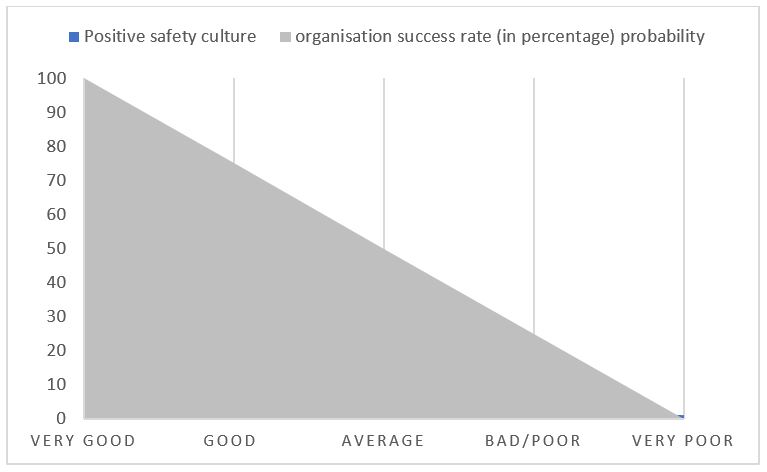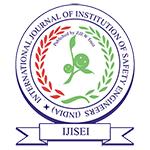Safety Culture in Organization: A Review

Volume 3, Issue 2, January – March 20
Safety Culture in Organization: A Review
Shamim Rayani
B.E, MBA, PDIS from RLI, M.Sc (Environment Science), NEBOSH-IGC (U.K.), SMISE
Corporate Safety, Health & Environment- Water Business Voltas Limited, Patna- Bihar
Email id: Shamimrayani@voltas.com
Abstract
Safety culture is main parameter of any organization to identify success or failure of their business. Positive Safety culture Plays vital role within organization to create safe Healthy work environment to control work place risk through positive thought, effort and dedication of employees. At current Scenario, safety is very important parameter of any business for every organization. Safety culture is associated with organization business and it helps to grow organization profit. This study is carried out to identify positive and negative impacts of Safety Culture; Evaluation method of organization safety culture, method to develop positive safety culture, causes of negative safety culture and obstruction create during developing positive safety culture like points is discussed. Therefore, this paper is very helpful to learn and create positive safety culture in any organization to prevent accident and achieve excellent organization reputation.
Keywords: Positive Safety Culture, Accident Prevention, Safety Culture Evaluation
Method, Method to develop Positive safety culture
1. Introduction
Safety culture is major key element of success or failure of any organization business. Safety Culture may be positive or negative within organization, it depends on organization top management commitment and enforcement of Safety rules, regulation and codes. Positive Safety culture means, employees contribute their dedicated efforts, values, belief and acts accordingly to control work place risk and maintain high safety standard within their organization. Poor Safety Culture means employees not contribute their belief, effort, values to control work place risk and its results organizational harm in term of accident, Property damage, Poor organization reputation, decrease of productivity and can result prosecution by respective government authority and effects to organization. In simple word, we can say that Poor safety culture lead to cause of organization failure. Poor Safety Culture is also known as negative Safety culture.
Positive Safety Culture always helps to gain profitable business and it increases organization productivity. In other Term, impacts of Positive culture may be increase organization reputation, increase work efficiency of worker, control work place risk, employees belief and follow safety laws, procedures, guidelines and its results increase productivity and achievement of zero harm. Safety culture is major key element that shows organization safety performance and safety performance depends on organization positive or negative safety culture. Organization is defined as an entity where multiple people are engage to perform activity as planned by their team, institution or an organization or industries. Safety culture parameter, help to shown industries reputation and increase their profitability among top organization in country as well as world level. Safety culture is defined as employees belief, perception, values and effort that helps to prevent unsafe practices and control potential sources of harm at work place.
An organization with a poor or negative safety culture should recognize and accept to cause of their failure (causes of poor safety culture) and need to seek opportunities to improve in their safety management system of organization to develop positive safety culture.
2. How positive safety culture help to Prevent Accident and success of organisation
Positive safety culture creates positive behavior among employees including workmen and organisation employees dedicatedly follow all safety rules, procedures and guidelines to mitigate workplace hazard and prevent unsafe practice. In simple ways, we can say that Positive safety culture of any organization control or minimize risk up to tolerable level. Following are few benefit of positive safety culture.
- Create safety awareness among organization employees including workmen.
- Employees dedicated to follow safety, rules and regulation through self-desire.
- Positive safety culture create good reporting culture, it help to identify safety related deficiency and taking corrective/ Preventive action.
- Safety culture creates good work environment, employees give priority first to safety. Employees care for its own safety and other of organization.
- Help to execute company Safety laws, Procedure & Guidelines easily.
- Create positive behavior and employees dedicatedly to involve in safety activity such as training, meeting etc.
- Boost to moral of employees and support to create fearless work environment among employees.
- Help to achieve excellent organization reputation and increase productivity.

2.1 Positive Safety Culture versus Probability of organization Success (percentage)

| Safety Culture Classification | Safety Culture Rating | Success Rate Probability (Percentage) |
| Very good | 5 | 100 |
| Good | 4 | 80 |
| Average | 3 | 60 |
| Poor/Negative | 2 | 40 |
| Very poor | 1 | 20 |
Table 1, As Per ISEI manuals
3. Impacts of Safety Culture in Organization:
Impacts of safety culture may be positive or negative. Positive Safety culture within organization results, Positive impacts in term of control workplace risk, increase business opportunities and became organization success. Poor or negative Safety culture within organization results, negative impacts in term of accident, poor market reputation, harm and business failure. Safety culture impacts are given in fig. (3).

4. Causes of Poor Safety Culture
Poor Safety Culture is also known as negative safety culture and it results organization failure in term of poor organization reputation, major harm, prosecution by legal authority in case of any fatality or major accident, decrease productivity etc. There may be several causes of Negative safety culture in organization. Few Major causes are
Poor Management Commitment: Main cause of poor safety culture is ineffective management commitment. Top management only considers organization profit instead of safety on first priority. Management not imagine or consider to indirect cost of poor safety culture, that how poor safety culture lead accident and result to business failure. Due to lack or no interest of Top management, safety culture decreasing day by day.
Objective & Target: In few organizations, ineffective or no objective related to safety decided by Management also results poor safety culture. If objective decided but target not fixed to achieve these objective within certain duration is also lead to create obstruction in positive safety culture.
Ineffective enforcement of Safety laws: Ineffective enforcement of safety laws, procedures and codes increase risk of harm at work place. There may be several causes of poor implementation of safety laws and procedures due to incompetence leadership and poor method of communication, poor method to identify work place hazard, Poor enforcement of respective state safety rules due to in-effectiveness enforcement of law by govt. authority, No support from top management to executive (Middle) level employees, always resulted to create negative safety culture.
Poor reporting culture: Poor reporting culture help to create negative safety culture. Cause of poor reporting culture may be fear work environment, heavy workload, ineffective implementation of SMS including no procedure and guideline to report non-conformity (N.C), Near miss, Incident. Blame culture is also part of negative safety culture. Whenever any employees report to near miss or any N.C then concern person, take in negative way instead of taking positively and working to resolve issue and control work place risk.
Poor Resources: Resources is also cause of safety culture, Resources may be in terms of Suitable and standard Personnel protective equipments, Skill manpower including safety personnel, Training center etc. Non- availability or poor availability of resources increase negative safety culture day by days within organisation.
In simple ways, causes of poor Safety Culture may be Poor management commitment, thinking on Profit first before Safety, Culture of Fear, Ineffective Leadership and poor method of communication, Noncompliance of Safety rules, standard, rules and procedures, No provision of safety induction for new employees, Training and not conducting motivational program like factor create Negative safety culture among organization. Poor health condition, Negative thoughts, behavior and attitudes of are main human factor of Poor safety culture.
5. Method to evaluate Safety Culture within organization
Several parameter used to evaluate safety culture within any organisation. Following are Few major parameters:
Key performance Indictor: Key performance indicator is major element to evaluate safety culture of any organization. Accident Rate (A.R), Frequency rate (F.R), severity Rate (S.R) are few important parameter to check organization safety culture. Accident Rate (A.R), Frequency rate (F.R), severity Rate (S.R) can be calculated as per guidelines of IS 3786.Apart from this Activity rate, leading, lagging indicator like parameter is very helpful to evaluate organization safety performance and culture.
Physical visit at site: Physical visit at site, help to identify potential sources of harm at work place and unsafe practices. On based on this, risk level at site can be evaluated. Housekeeping, PPE’s compliance, Compliance of machine guarding, Compliance of welfare amenities, compliance of respective state legislation and codes, compliance of work permit, Lockout/Tagout system can be checked to evaluate organization safety culture.
Consultation with employees: It will help to ask question and identify employee behavior. It will also help to identify management commitments, supports from management to lower level employees to resolve safety issue and their involvement in safety activity, to know working hours and required resources such as trained personnel, Safety material available at site is adequate or not. Mainly, it helps to identify behavior of employees and how they contribute their effort to control workplace risk.
Compliance status: Check the status of compliance as per respective state government safety rules, standard & procedures to evaluate safety culture of organisation. Compliance status of Safety observation report, compliance status of Near miss and Incident investigation, Compliance status of work permit system, Hazard identification and risk assessment (HIRA) done of applicable activity and adequate control measure taken as per HIRA documents, Notice received from government authority for safety violation and their compliance status, Safety audit conducted and their compliance status like parameters are identified as per nature of organization and check their compliance status to evaluate organisation safety culture.
In simple method, Safety KPI (key performance indicator), Compliance status of safety, rules and regulation and consultation with employees and physical visit at site are main keys to identify organisation safety culture. In Fig. 4, Safety culture is divided in two categories and suitable procedure with steps wise is given to evaluate safety culture and recommendation to improve safety culture.
Safety Culture evaluation Method

Note: A.R means accident rate, F.R means Frequency Rate, S.R means severity rates
6. Method to develop positive Safety Culture
Positive safety culture in any organisation can develope through effective implementation of Safety management system (SMS), to ensure compliance as per respective state Safety rules and regulation, to improve reporting culture, avoid to develop blame culture, Effective hazard identification, risk assessment and risk control method, delegate role and responsibility clearly, involvement of workers in safety activity with management, To create strong trust between management and employees, Top management must recognize to all employees like factor help to develop positive thought and behavior among employees.
Identify all element of Safety management system that is applicable for organization and ensure compliance accordingly. Safety Policy, Planning, Implementation & Operation, Measurement and evaluation, checking and corrective action, management review are elements of safety management system. Safety Culture is results of implementation and compliance of Safety management system (SMS). Effective implementation of Safety management system create positive thought and attitude among employees. Effective communication, motivation, Training are also parameter of positive safety culture.
Strong management commitment, Management thinking on safety first on priority, avoid to develop culture of Fear, Effective Leadership, Compliance of Safety rules, standard, rules and procedures are effective parameter to develop positive safety culture. Provision of safety induction for new employees and need based Training is major factor. Positive safety culture is based on high level of trust and respect between employees including workmen and management of the organization. Work place must be free from any potential source of harm, employees behavior must be positive and they should enough knowledge and skill to ensure safety control measure in their work environment and motivate to others to adopt safety rules and practices.

7. Conclusion
Safety culture decides organization success or failure. Safety Culture can be categories as Two Types Positive Safety Culture and negative Safety Culture. Positive Safety Culture within any organisation minimize risk upto tolerable level. At current scenario, Safety is most important parameter for every organization to grow their business. Failure to ensure safety compliance or non-compliance may lead to cause of major organizational harm in term of fatality, Property damage, damage to environment and it results organisation failure. In many states, governments has implemented strictly safety laws therefore management focused of safety on priority. Strong management commitment, effective implementation of safety rules, regulation, codes, effective reporting culture, close supervision, adequate resources is main element of safety culture. Positive safety culture is based on high level of trust and respect between different level of employees such as top management level, middle management level, and Lower management level including workers.
References:
- Safety Management system in construction industries, Shahnawaz Rampuri, IJSEI, International Journal of Institution of Safety Engineers (India) Volume 1, Issue 1, Jan-Mar 2018
- Hofmann, D., Burke, M. & Zohar, D. (2017). 100 years of occupational safety research: From basic protections and work analysis to a multilevel view of workplace safety and risk. Journal of Applied Psychology, 102(3), 375-388. doi: 10.1037/apl0000114
- Zou P., (2011). Fostering a Strong Construction Safety Culture, Leadership and Management in Engineering, pp.11-22.
- IS 3786 Methods for computation of frequency and severity rates
- Hoffmeister, K., Gibbons, A., Johnson, S., et al. (2014). The differential effects of transformational leadership facets on employee safety. Safety Science, 62, 68-78. doi:10.1016/j.ssci.2013.07.004 Hofmann, D., Burke, M. & Zohar, D. (2017). 100 years
- O’Dea, A., & Finn, R. (2003). The role of managerial leadership in determining workplace safety outcomes. Suffolk: HSE Book.
- Guldenmund, F.W. (2010). Understanding and exploring safety culture. Oisterwijk: Uitgeverij BOXPress.
- Institution of Safety Engineers (India), Manuals
- Study of Machinery Safety in Industries: A review, International Journal of Institution of Safety Engineers (India), Volume 2, Issue 1, Jan-March.19, Page 08-12

Very nice and authentic article .